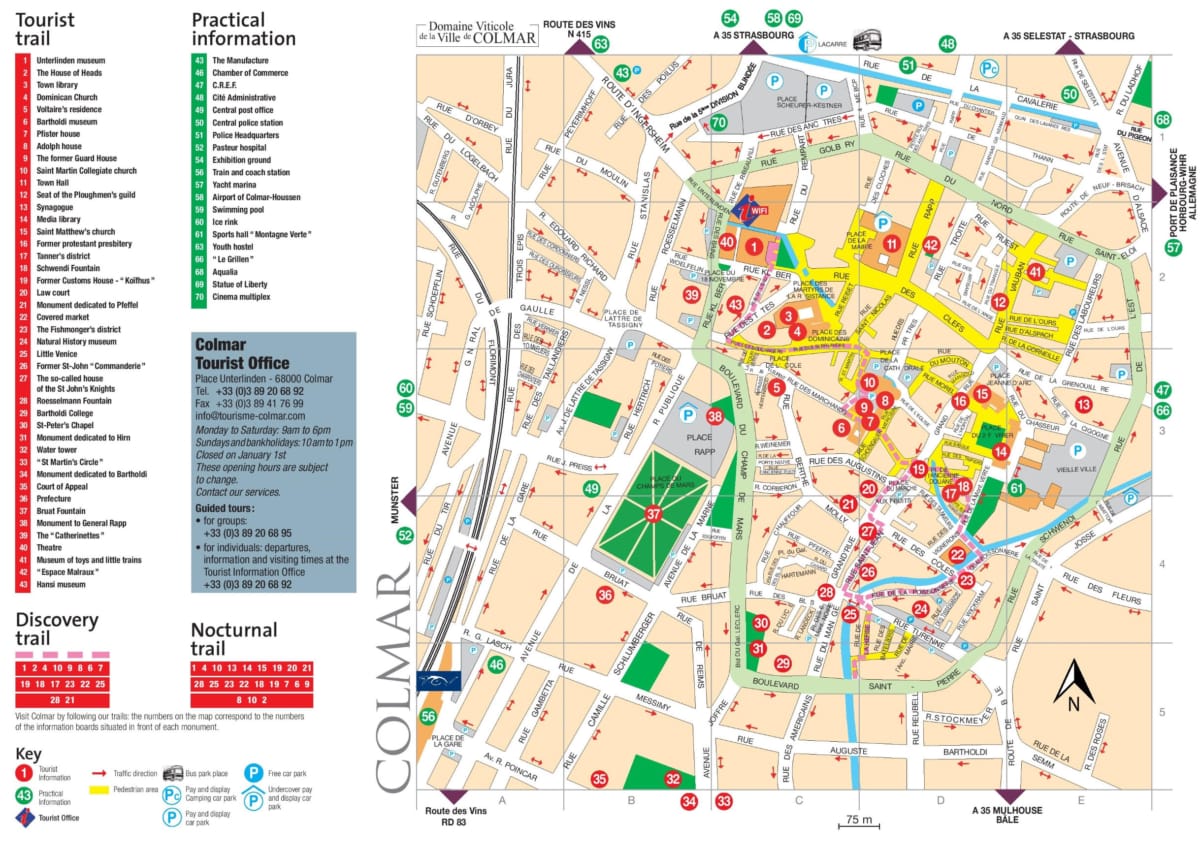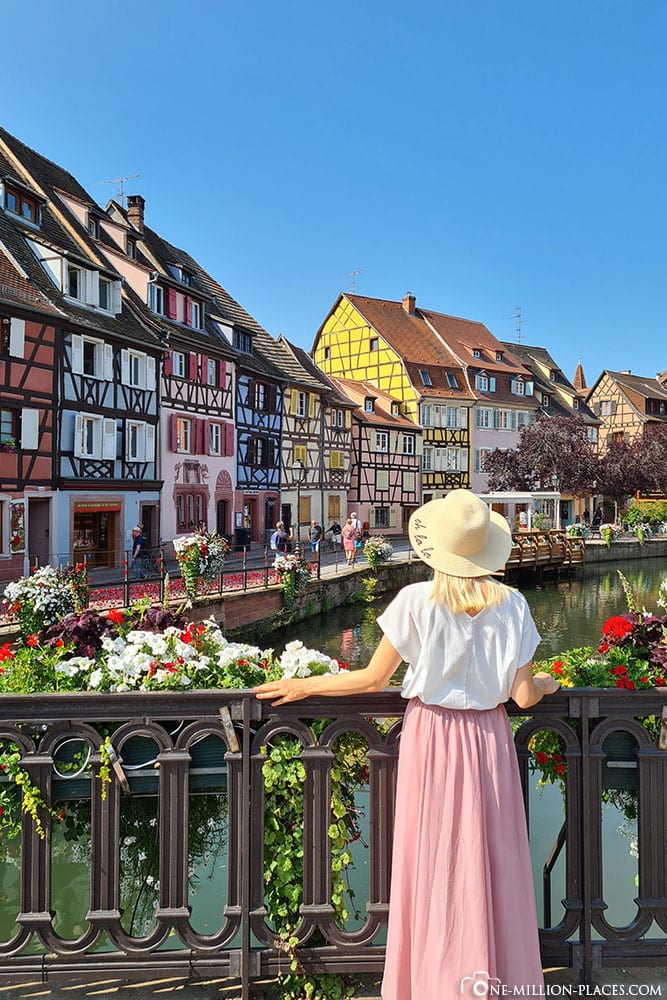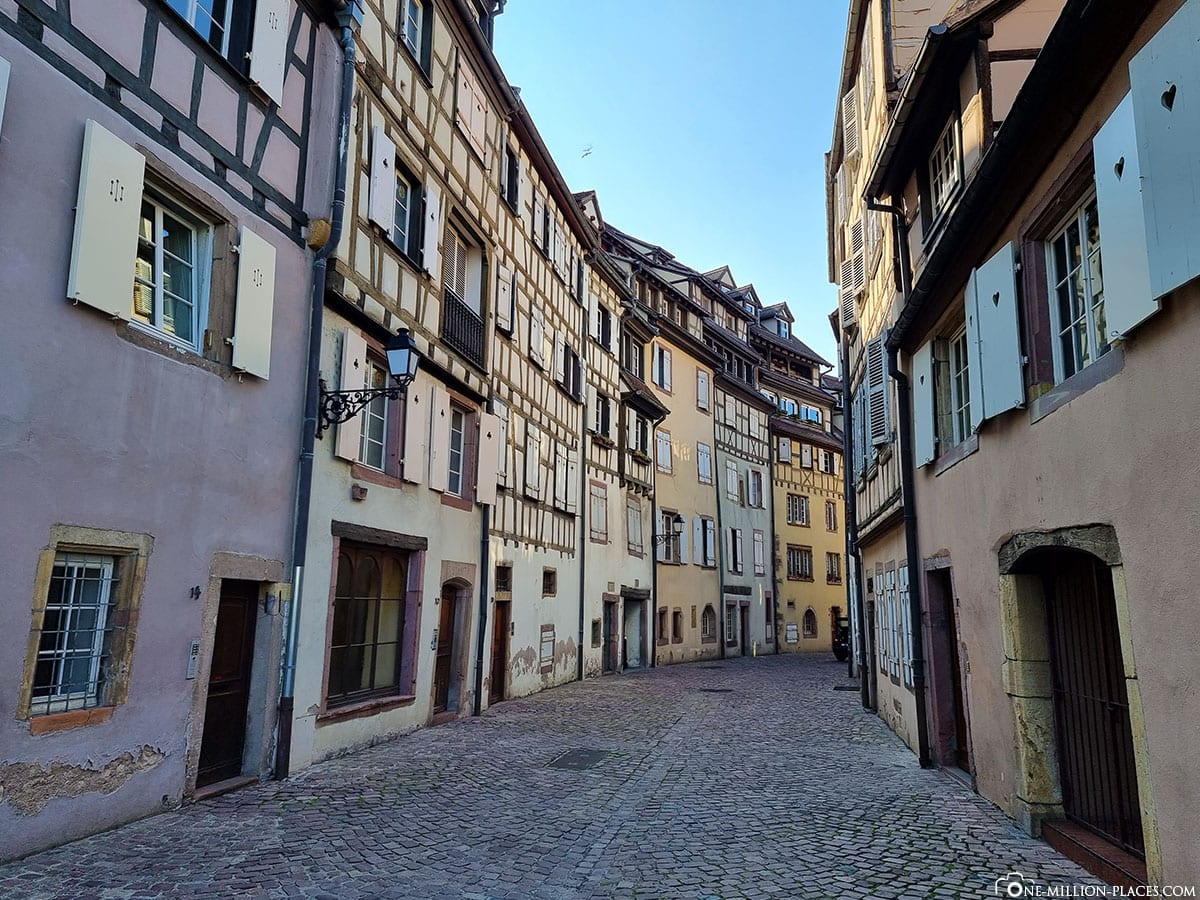A visit to the beautiful, romantic town of Colmar had been on our travel list for a very long time. And so, on a beautiful summer day, we set off for Alsace and spent a few days exploring the small town of Colmar and the surrounding region. The villages are mainly characterized by cobblestone streets & half-timbered houses and take you back to the time of the Middle Ages and the Renaissance. That is at almost every corner awaited us dreamlike postcard motifs 🙂

Table of contents
Things to know about Colmar (France)
Colmar is a town in the Alsace region of northeastern France, about 25 km from the German border. It is – after Strasbourg and Mulhouse – the third largest city in Alsace and has about 70,000 inhabitants. Colmar is known mainly for its very well preserved architectural heritage, its countless cobblestone streets, half-timbered houses and medieval ambience. The town is located on the Alsace Wine Route, which is considered one of the oldest tourist routes in France, having been established in 1953. Over a length of 170 kilometers, it winds through the wine-growing region of Alsace and also passes through Colmar, which is considered the cultural center of the Alsace Wine Route.
Colmar has a long history: the first documentary mention of the city was attested in 823. In 1226 it was elevated to the status of an imperial city by Emperor Frederick II. In 1679 Colmar passed to France in the so-called Peace of Nijmegen.
We stayed at Les Appartements de la Gare, a beautiful 55m² apartment near the main train station. From there, it was only about a 10-minute walk to Champ-de-Mars Park and the old town. In addition, you can park directly opposite the accommodation on the large parking lot “Place du Capitaine Dreyfus” (location in Google Maps) for free in Colmar, which is really great. The price for the apartment was 230 EUR for 4 nights.
A map of Colmar
The old town of Colmar is best explored on your own and on foot in one day. Of course, it is nicer if you have 2 or 3 days. A good tourist map with all important sights can be downloaded here or another version here for free.
The top 15 sights in the old town of Colmar
Colmar is definitely one of the most beautiful and worth seeing cities in France. Therefore, we would like to present you the most famous sights and the most beautiful Instagram and photo spots.
Old city wall
Like many medieval cities, Colmar had a city wall. The original city wall was built between 1216 and 1220 and at that time was 2 kilometers long and up to 8 meters high. After the advent of cannons, the city walls were strengthened and extended with bastions and moats.
Today, unfortunately, almost nothing remains of the old city wall. The most important remains of the medieval fortifications of Colmar were demolished in 1673 by order of François Michel Le Tellier de Louvois and the bricks were used to build the former hospital. Only a section about 100 meters long along the river Lauch north of the market hall has been preserved and registered as a historical monument since 1929.
Quai de la Poissonerie
The Quai de la Poissonerie connects the tanners quarter and the picturesque Little Venice and is for us one of the most beautiful quarters in Colmar.
Quai de la Poissonerie – sometimes called the fishermen’s quarter – runs along the Lauch river, which is canalized on its way through the city (Vieux lit de la Lauch) before it flows into the Ill between Colmar and Horbourg. Since the Middle Ages, most of the professional fishermen of the city lived here, who had united with the bargemen in a large guild. The fish caught in the watercourses were stored in fish tanks placed along the Lauch and sold on the quay.
In 1706, a huge fire destroyed more than forty houses of the neighborhood, including the house of Jean Henri Frid, which was one of the most beautiful in the city. A restoration campaign carried out between 1978 and 1981 gave a new face to the entire neighborhood, as the half-timbering of numerous houses was exposed.
The colorful backdrop of half-timbered houses looks a bit like being in a theme park 🙂 Nevertheless, the fishermen’s quarter is definitely the most beautiful photo motif for us and one of the most famous Instagram spots of the city of Colmar.
Market Hall
The market hall of Colmar was built in 1865 on the banks of the Lauch in the historic district not far from the Koïfhus and Rue Turenne. The massive pink sandstone ashlar building is the work of architect Louis-Michel Boltz, who also designed the Colmar Municipal Theater (1849). Brick, iron, and cast iron, among other materials, were used for construction, marking Colmar’s transition into the industrial age. In the southwest corner of the market hall, in a niche, there is a bronze-colored fountain crowned by the statue of a small winemaker. Since its restoration in 2010, the Colmar market hall once again hosts a permanent market, complemented by outdoor stalls every Thursday. About 20 vendors offer fruits and vegetables, cold cuts, cheese, fish and other delicacies.
Tanner Quarter
Another nice photo spot is Petite Rue des Tanneurs, part of Colmar’s tanners’ quarter (Quartier des Tanneurs), which starts just behind the market hall. The in 17. and 18th century half-timbered houses in the neighborhood once housed the families of tanners and are relatively high compared to other buildings. The open and well-ventilated gable roofs of the half-timbered houses are also characteristic. These were used by the tanners to dry the furs on the top floor in the attics, which can still be admired today. The Gerber neighborhood was the subject of a comprehensive restoration program between 1968 and 1974 and included 33 property units, 27 of which were restored. The most spectacular measure was the plucking, i.e. the exposure of the wooden framework and the careful cleaning of the masonry.
Rue des Marchands
The Rue des Marchands runs from the Grand Rue to the Rue Berthe Molly across the old town and is for us – next to the Rue de la Poissonnerie in the fishermen’s quarter – the most beautiful street in Colmar. Here you can find an incredible number of beautiful half-timbered houses, cafes, souvenir stores, restaurants and much more.
In addition, the Musée Bartholdi is located in the Rue des Marchands. The museum, built in 1922, is located in the birthplace of the sculptor Auguste Bartholdi and is dedicated to the presentation of the artist’s works, focusing on sculptures and paintings. At the western end of Rue des Marchands, in a side street, is the house where the French philosopher and writer Voltaire lived.
Maison Pfister & Maison Adolph
The Pfister House is probably the most famous house and one of the architectural landmarks of Colmar. It was built in 1537 for the hatter Ludwig Scherer. However, the current name of the house comes from a family that lived there between 1841 and 1892. The Maison Pfister has been a listed building since 1927.
At the back of the Maison Pfister is the Maison Adolph. The house was built as early as the mid-14th century, making it one of the oldest buildings in Colmar. The name comes from the Adolph family, who uncovered the Gothic window openings at the end of the 19th century. The fountain at the foot of the Adolph House, crowned by a gallows with two lion heads, is dated 1592 and was originally located in Rue Mercière.
Old Police Station (Salle du Corps de Garde)
The old police station is located in the middle of the old town, directly opposite the Martinsmünster and next to the Maison Adolph. Built on the former 13th-century Saint-Jacques Chapel, which served for a time as the town hall, the building was converted into a guardhouse in 1575. The guard was located on the first floor, on the upper floor there were apartments and under the arches used to be a small market for nuts and oil seeds.
The building impresses with decorative ornamentation, which can be found especially on the round-arched entrance gate and the loggia above. The loggia was once used by judges as a tribune for pronouncing judgments. From 1860, the building served as the office of the military quarters and later as a police station. The Salle du Corps de Garde is considered one of the most beautiful Renaissance-style buildings from the second half of the 16th century in Alsace.
Here you can find a nice historical photo of the old police station and the small merchants market.
Collegiate Church of Saint Martin
Central to the old town is the Roman Catholic Collegiate Church of Saint Martin (Collégiale Saint-Martin), often referred to as St. Martin’s Minster. We had some trouble to get the huge church completely on a photo, because around the church is not so much open space – but somehow it worked out 😉
The present church building was erected between 1234 and 1365 and is today one of the most important Gothic buildings in Alsace. The top of the south tower burned down together with the roof truss in 1572. Three years later it was replaced by the original onion-shaped Renaissance lantern, which gives the church building its characteristic silhouette. Several restoration works took place in the church over the decades. During the last restoration works in 1982, foundations of an earlier church, built around the year 1000, were uncovered.
Museum Unterlinden
In downtown Colmar the Unterlinden Museum opened in 1853. It is located in the former 13th century Dominican convent “Unter den Linden”. The museum presents a remarkable collection of paintings and sculptures from the late Middle Ages and the Renaissance, and has one of the masterpieces of Western art: the Isenheim Altar, made between 1512 and 1516 by the painter Matthias Grünewald and the carver Niklaus von Hagenau. The collection of modern art consists of works by great artists such as Monet, Guillaumin, Bonnard, Delaunay.
The Museum Unterlinden is open daily (except Tuesdays) from 9 a.m. to 6 p.m. and admission for adults is 13 EUR. Since we are not the big art fans, we have not visited the museum and only photographed from the outside.
Grand Rue
The Grand Rue is one of the main streets in the old town of Colmar and runs from north (Rue des Clefs) to south (Rue des Blés). The Grand Rue is home to some of Colmar’s important buildings, such as the District Court, the Koïfhus or the Église Saint-Matthieu.
Built in 1480, Koïfhus was once the economic center of old Colmar, a place of transit and storage of all goods. The first floor of the building served as an office for the customs, while the upper floor had an administrative and political function (council chamber). When the trading privileges were abolished in the 19th century, the first floor was used for various other purposes, notably as a theater, school or convention center. The building has been a listed building since 1974 and was undergoing extensive restoration during our visit, so unfortunately we couldn’t really see it in its full glory.
Place de l’Ancienne Douane
A very nice public square in the city center is the Place de l’Ancienne-Douane, which owes its name to its proximity to the Old Customs House (Ancienne Douane). The square, crossed by a small watercourse, is a link between the Place de la Cathédrale and the Petite Venise district. In the center of the square is the Schwendi Fountain, built in 1898 by Auguste Bartholdi, which features a bronze statue of Lazare von Schwendi.
Little Venice
A truly enchanting place in Colmar is Little Venice (La Petite Venise). This district begins at the Market Hall, passes through the Fish Bank and reaches the Turenne and Saint-Pierre bridges.
Most of the buildings in the district are small half-timbered houses painted in the traditional colors of Alsace and built between the 14th and 18th centuries. Everywhere you can find small restaurants, wine bars, hotels, pastry shops and boutiques. One of the most popular photo spots is on the bridge in Rue Turenne. From here you have a picturesque view of the houses facing the river. Little Venice is one of the best preserved medieval neighborhoods in the city and totally enchanted us. We stopped here every few meters and took countless photos, because the scenery is simply gorgeous.
Place Jeanne D’arc
The history of Place Jeanne D’arc dates back to the 14th century, when a horse and cattle market operated here. Today the square is used mainly for the annual Christmas market. The market, overlooked by a beautiful ensemble of half-timbered houses, recreates the atmosphere of a traditional Alsatian village at this time with its Christmas cottages, its church and its small flock of sheep.
Not far from the square is the Colmar Synagogue, inaugurated in 1843. The monumental synagogue building was built in the neo-Romanesque style and is the only synagogue in Alsace to have a small bell on the roof.
Park Champ-de-Mars
The Champ-de-Mars is a public park and the green lung of the city of Colmar. You have to go back to 1745 to find the origins of today’s Champ-de-Mars Park. At that time it was a public promenade used especially for military exercises of the National Guard as well as for ceremonies. In 1864, a fountain with a statue created by the artist Bartholdi was erected in the center of the Champ-de-Mars in honor of Admiral Bruat. This fountain and the statue can still be seen today. In addition to the large lawns, children will especially enjoy a beautiful carousel from 1900, which is the largest carousel with wooden horses in France. And also the many water features invite especially in warm temperatures for a cool down.
A few meters from the park is the complex of buildings of the very photogenic prefecture of the Haut-Rhins department, built between 1862 and 1866. Colmar thus acts as the capital of the department and houses various administrative offices and administrative buildings as well as the official residence.
More photo spots in the old town
During our various walks through the old town of Colmar, we saw impressive buildings on almost every corner and discovered beautiful photo opportunities. These include, for example, the richly decorated building La Maison des Têtes (House of Heads), built in 1609 by order of Colmar merchant Anton Burger, which gave its name to the street in 1888. The mullions and transoms of the windows as well as the panels of the central bay window are decorated with 106 grinning heads. Directly opposite the famous “Maison des Têtes” is the Hansi Village and Museum, an exhibition by the famous Alsatian artist Jean-Jacques Waltz, also known as “Hansi”.
The Town Hall building was built from 1778 to 1782 as the town residence for the Cistercian Abbey and has served as the town’s town hall (L’Hôtel de Ville) since 1866.
And not only Brussels has a Manneken-Pis – also in Colmar you can find this special fountain figure. Little Julian is a copy of the famous Manneken-Pis from Brussels and is symbolic of the divided suffering of Brussels and Colmar during the First World War. In the inscription on the base of the small figure is written: “Belgian cheerfulness” and “Alsatian cheerfulness”. The little naked egg can be found on the right side of the justice building.
Another nice photo motif is the theater (Le Théâtre Municipal), built between 1847 and 1849 on a former outbuilding of the monastery of Unterlinden.
We found particularly imposing the building of the Superior Court (La Cour d’Appel), built from 1902 to 1906 in the park of the water tower (Parc du Château d’eau). Its facades, roofs and entrance hall with the staircase of honor were included in the inventory of historical monuments in 1985. Built in 1886, “Le château d’eau” is a 54-meter high water tower, considered the oldest preserved water tower in Alsace. It was once built on the highest point of the city and served to regulate the distribution of drinking water in Colmar. The tank has a capacity of 1200 m³ and was decommissioned in 1984.
Is Colmar worth a visit?
To make a long story short: Yes, definitely! Colmar is one of the most beautiful cities we have visited on our travels so far! 🙂
From the first moment we were impressed by this medieval town, the many colorful half-timbered houses, the imposing buildings and the flair along the river Lauch. There is something new to discover and photograph at every turn. And besides, we had perfect summer days with blue skies and pleasant temperatures.
And the nice thing is: not only Colmar is worth seeing. The many other cities in Alsace such as Strasbourg, Eguisheim, Ribeauville, Riquewihr or Kaysersberg are also definitely worth a visit. Some of these are only 10 minutes away from Colmar by car. Please have a look at our other travel reports.
The most beautiful Alsace Villages (France)
Half-timbered towns, wine villages, castles, medieval city walls and tarte flambée... we spent a few days in Alsace, France. Here you can find our travelogues of some of the most beautiful towns in the region. » Strasbourg - Tourist Attractions, Things to Do & Photo spots
» Strasbourg - Tourist Attractions, Things to Do & Photo spots» Colmar - Top 15 sights in the old town
» Kaysersberg – Sights, Old Town & Castle
» Riquewihr - One of the most beautiful villages in France
» Eguisheim - Top sights of the medieval town
» Turckheim - A day trip from Colmar
» Ribeauvillé – Top Sights & Photo Spots
» Neuf-Brisach - own and Fortress (UNESCO World Heritage)




